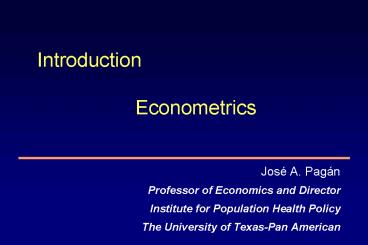Introduction Econometrics - PowerPoint PPT Presentation
1 / 12
Title:
Introduction Econometrics
Description:
Introduction. Econometrics. Jos A. Pag n. Professor of ... The University of Texas-Pan American. Introduction. Econometrics means 'economic measurement' ... – PowerPoint PPT presentation
Number of Views:339
Avg rating:3.0/5.0
Title: Introduction Econometrics
1
Introduction Econometrics
- José A. Pagán
- Professor of Economics and Director
- Institute for Population Health Policy
- The University of Texas-Pan American
2
Introduction
- Econometrics means economic measurement
- It combines economic theory, mathematical
economics, economic statistics and mathematical
statistics - economic theory (e.g., when price goes up,
quantity demanded goes down) - mathematical economics (e.g., express economic
theory using math) - economic statistics (data)
- mathematical statistics
3
Classical methodology
- Statement of theory or hypothesis
- Specification of mathematical model
- Specification of econometric (statistical) model
- Obtain data
- Estimate parameters of the model
- Hypothesis testing
- Forecasting
- Use the model for policy
4
Example Keynesian theory of consumption
- 1. Statement of theory or hypothesis
- 0ltMPClt1
- 2. Specification of mathematical model
- Y ß1 ß2X 0 lt ß2 lt 1
- 3. Specification of econometric (statistical)
model - Y ß1 ß2X u
- 4. Obtain data
- See Table I.1, page 6.
5
Example Keynesian theory of consumption (2)
- 5. Estimate parameters of the model
- Y -184.08 0.7064Xi
- 6. Hypothesis testing
- Is 0.70 statistically less than 1?
- 7. Forecasting
- If X19977269.8 then Y 4951.3167
- 8. Use the model for policy
- Pick value of X to get desired value of Y (Y and
X are called target and control variables,
respectively)
6
Chapter 1 The nature of regression analysis
- Galtons regression to mediocrity
- Regression analysis study of the dependence of
one variable (the dependent variable) on one or
more other variables (the explanatory variables) - The goal is to predict the mean value of the
dependent variable based on known values of the
explanatory variables - Example 1 Fathers and sons heights (Fig. 1.1,
P. 18) - Example 2 Education and earnings (human capital
function)
7
Chapter 1 The nature of regression analysis (2)
- In regression analysis we are interested in
statistical dependence among variables, not in
deterministic relationships. - Regression analysis deals with dependence but not
necessarily with causation. - Regression is different from correlation in the
sense that we define a dependent variable
(random) and an explanatory variable (fixed)
whereas in correlation both variables are random. - A random (or stochastic) variable is a variable
that can take any set of values, with a given
probability.
8
Types of data
- Time series data (data collected daily, monthly,
yearly) - daily stock market data, monthly unemployment
rates - Cross-sectional data (data collected at one point
in time) - a one-time household survey, a poll
- Pooled (cross-sectional observations collected
over time, but they dont have to be the same
person, firm, etc.) - combining data from say a yearly household survey
over multiple years - Longitudinal/panel data (data from the same
cross-sectional units collected over time) - collecting data on the same persons over time
(e.g., the National Longitudinal Survey of Youth
Health and Retirement Study)
9
Chapter 2 Two-variable regression analysis
- Unconditional expected value E(Y)
- Conditional expected value E(Y X)
- A population regression curve is simply the locus
of the conditional means of the dependent
variable for the fixed values of the explanatory
variables - Conditional expectation function (population
regression) E(Y Xi) f(Xi) - Population regression function could be something
like E(Y Xi) Y ß1 ß2Xi - ß1 and ß2 are called regression coefficients
10
Chapter 2 Two-variable regression analysis (2)
- Linear regression means a regression that is
linear in the parameters - A linear regression can be non-linear in the
variables - Example Y ß1 ß2X2
- A linear regression must be linear in the
parameters - Some non-linear regression models can be
transformed into a linear regression model (e.g.,
YaXbZc can be transformed into lnY ln a bln
X cln Z)
11
Chapter 2 Two-variable regression analysis (3)
- Deviation of an individual Yi around its expected
value is given by - ui Yi - E(Y Xi), or Yi E(Y Xi) ui
- If we take the expected value on both sides of
the equation above, we get that E(ui Xi) 0 - Thus, the assumption that the regression line
passes through the conditional means of Y implies
that the conditional mean values of ui are zero - Disturbance term ui captures all the variables
omitted from the model. Possible reasons include - Vagueness of theory
- Unavailability of data
- Core variables versus peripheral variables
- Intrinsic randomness in human behavior
- Poor proxy variables
- Principle of parsimony
- Wrong functional form
12
Chapter 2 Two-variable regression analysis (4)
- Lets now move from the population to the sample
- Sample regression function Yi ß1 ß2Xi
- Yi estimator of E(Y Xi) ß1 estimator of
ß1 ß2 estimator of ß2 - Estimator rule, formula or method that tells us
how to estimate the population parameter - Estimate particular numerical value obtained
using the estimator - Note that Yi ß1 ß2Xi ui
- ui residual term (it is an estimate of ui).
- Our main objective in regression analysis is to
estimate the population regression function using
the sample regression function. - Can we devise a rule that will make our sample
regression function as close as possible to the
population regression function?








![[READ DOWNLOAD] The Effect: An Introduction to Research Design and Causality PowerPoint PPT Presentation](https://s3.amazonaws.com/images.powershow.com/10087195.th0.jpg?_=20240727042)


![get [PDF] Download The Effect: An Introduction to Research Design and Causality PowerPoint PPT Presentation](https://s3.amazonaws.com/images.powershow.com/10087196.th0.jpg?_=20240727042)


![[READ DOWNLOAD] The Effect: An Introduction to Research Design and Causality PowerPoint PPT Presentation](https://s3.amazonaws.com/images.powershow.com/10088344.th0.jpg?_=20240730019)
![get [PDF] Download The Effect: An Introduction to Research Design and Causality PowerPoint PPT Presentation](https://s3.amazonaws.com/images.powershow.com/10088345.th0.jpg?_=20240730019)















